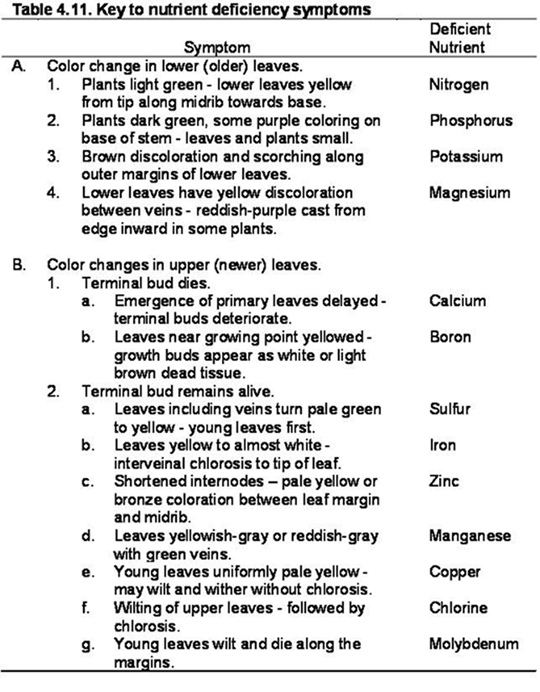Nutrients
Secondary Nutrients
Essential plant nutrients, chemical symbols and sources
| Mostly from Air and Water (non-mineral) | From Soil and/or Fertilizers (Mineral) | ||
|---|---|---|---|
| Element | Symbol | Element | Symbol |
| Carbon | C | Nitrogen | N |
| Hydrogen | H | Phosphorus | P |
| Oxygen | O | Potassium | K |
| Calcium | Ca | ||
| Magnesium | Mg | ||
| Sulfur | S | ||
| Iron | Fe | ||
| Mangeanese | Mn | ||
| Zinc | Zn | ||
| Copper | Cu | ||
| Boron | B | ||
| Molybdenum | Mo | ||
| Chlorine | Cl |
The essential plant nutrients may be grouped into three categories.
They are as follows:
- Primary nutrients - nitrogen, phosphorus and potassium
- Secondary nutrients - calcium, magnesium and sulfur
- Micronutrients - iron, manganese, zinc, copper, boron, molybdenum, and chlorine
| Secondary Elements | |
|---|---|
| Calcium (Ca) | Calcium fertilizers are not usually needed in Oklahoma. Common sources of supplemental Ca are lime and gypsum. |
| Calcium Carbonate (Lime) | 20-40% Ca |
| Calcium Sulfate (Gypsum) | 23% Ca, (18.6% Sulfur) |
| Normal Superphosphate | 22% Ca, (20% P2O5, 12% Sulfur) |
| Magnesium (Mg) | The most common sources of magnesium are magnesium sulfate and dolomitic lime. |
| Magnesium Oxide | 52% Mg |
| Magnesium Sulfate | 16% Mg |
| Potassium - Magnesium Sulfate (Sul-Po-Mag, K-Mag) | 11% Mg, (22% K2O, 22% Sulfur) |
| Dolomitic Limestone (varies) | 12% Mg |
| Sulfur (S) | Sulfur is most available when supplied in the highly water soluble sulfate form. Ag. sulfur (elemental sulfur) can be used, but requires biological oxidation over time to convert the elemental form to available sulfate. |
| Calcium Sulfate (Gypsum) | 17% S (22% Ca) |
| Potassium Sulfate | 17% S |
| Sulfate of Potash, Magnesia | 22% S |
| Ammonium Sulfate | 24% S |
| Normal Superphosphate | 12% S |
| Ammonium Thiosulfate | 26% S |
| Boron (B) | A sodium borate (solubor) containing about 20% B is the source of B most commonly used in liquids. Boric acid and other soluble forms containing between 14 to 20% B are also suitable for liquid mixes. |
| Borax | 11.3% B |
Exerts from Oklahoma Soil Fertlity Handbook 2006 (Zhang and Raun 2006).
Micronutrients
Zinc (Zn), Iron (Fe), Copper (Cu), and Manganese (Mn):
The micronutrient elements can be discussed as a group since their sources are somewhat similar. Industry separates the compounds into two general categories; inorganic and organic. Inorganic include sulfates, oxides, carbonates and chlorides. The term organic applies primarily to chelated products and some sequestered materials. Most chelates, and particularly liquid products, can be mixed with liquid without difficulty.
| Micronutrients | ||
|---|---|---|
| Zinc | ||
| Zinc Sulfate | 25-36% Zn | |
| Zinc Oxide | 50-80% Zn | |
| Zinc Chloride | 48% Zn | |
| Zinc Chelate | 9-14.5% Zn | |
| Iron | ||
| Ferrous Sulfate | 20.1% Fe | |
| Ferric Sulfate | 19.9% Fe | |
| Ferrous Ammonium Sulfate | 14.2% Fe | |
| Ferric Chloride | 34.4% Fe | |
| Iron Chelate | 10% Fe | |
| Copper | ||
| Copper Sulfate | 25% Cu | |
| Manganese | ||
| Manganese Sulfate | 23-28% Mn | |
| Molybdenum (Mo) | Ammonium molybdate is satisfactory for liquids. Sodium molybdate can also be used although it is less soluble than ammonium molybdate. Since Mo is applied in ounces per acre, liquids are ideal for getting even distribution. | |
| Sodium Molybdate | 39.7% Mo | |
| Ammonium Molybdate | 54.3% Mo | |
| Chlorine | Chlorine has only recently been found deficient in Oklahoma soils. The deficiency in wheat on deep sandy soils near Perkins, OK can be corrected using muriate of potash (0-0-60). This is the common source of potassium, which is usually also deficient in these sandy soils. |
Exerts from Oklahoma Soil Fertlity Handbook 2006, (Zhang and Raun 2006).
Table 4.11 from Oklahoma Soil Fertility Handbook 2006, (Zhang and Raun 2006).

